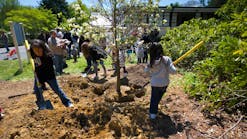About the author: Sean Darcy is a regional regulatory manager for Contech Engineered Solutions. Darcy can be contacted at [email protected].
Green infrastructure (GI) facilities, especially infiltration and bioretention facilities, are important components of a low impact development approach. To put it simply, their role is to provide the same runoff reduction services that the undeveloped landscape would provide, but in a much smaller footprint. Typically, the infiltration rate of native soils and the desired drawdown rate dictate the size of a facility. Some factor of safety is applied to hedge against infiltration rate decline due to long-term loading. Safety factors also can be added to compensate for uncertainty in infiltration rate measurements, construction diligence or material properties like amended soil permeability. All of these potential risks are important to account for, but facility design is uniquely controllable by storm water design engineers.
One approach to ensuring longevity is to maximize the surface area of the system. This provides more opportunity for accumulation of gross solids, and more soil volume to intercept and store finer solids that could depress infiltration rates over time. However, this approach comes at a cost, especially where land values are high, because facilities can end up being significantly oversized.
For BMPs with adequate drop—for example, subsurface infiltration galleries—it probably is more cost-effective to install upstream pretreatment facilities. Ideally, for sites with low to moderate loading, a biofilter or media filter would be specified to remove silt-size particles that may clog an infiltration system or engineered media. These systems can be maintained more frequently and at a much lower cost compared with rehabilitating a large bioretention system or subsurface infiltration gallery. Where this is infeasible due to high gross solids loads or high flow rates, a properly sized hydrodynamic separator can provide spill protection as well as removal of gross solids, fine sand, oil and grease.
Landscape-based systems like bioretention cells can be more difficult to pretreat, because typically there is limited upstream head available, as runoff is introduced through one or more curb inlets or curb cuts. The area around the inlet is most vulnerable to build-up of sediment, trash, debris, vegetation overgrowth and/or soil mounding. It is easy to make certain that the design does not include vegetation near the inlet entrance, or that vegetation is removed from the inlet of the facility if it prohibits runoff from entering.
Small facility design also can benefit from incorporating additional sediment retention capacity in or near the receiving inlet. Recessed concrete inlets have been used with moderate success; however, they cannot replicate the sediment storage capacity and effectiveness of a sump with a wet pool or a sedimentation forebay. In areas that utilize deicing sand, the addition of a sump or sedimentation forebay can prevent premature surface clogging of the biofiltration surface and improve the long-term function of the facility.
The irony here is that addition of pretreatment facilities may actually reduce the capital cost of a GI facility by shrinking its size, and will almost certainly reduce its long-term operational cost while increasing its resiliency. Unfortunately, the relationship between pretreatment robustness and facility longevity typically is not reflected in design guidance regarding selection of proper safety factors. The result can be a rather arbitrary and costly decision to lock in minimum size requirements or use exorbitant safety factors. Instead, putting the focus on management of fine sediments and gross solids, the most common pollutants causing failure, will produce designs that are protective and cost-effective.
Download: Here





